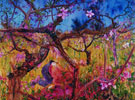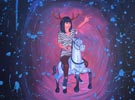The bright tone, clear structure as well as the gorgeous style of Lan Yi’s oiling gives people deep impression at the first sight. Before such a steady style was established, Lan Yi had gone through colorful experiences in his life of art. He learned from He Duoling in his childhood and later he entered the oil oiling department of Sichuan Fine Arts Institute. From then on, he took on a special affection of early modernist art. Influences from Van Gogh, Picasso as well as sur-realist artists such as Dali and Magritte are especially obvious on him. For Lan Yi, this kind of influences is mainly represented in his interests in "formal language" and "Imagination". Actually, early when he was a middle school student, Lan Yi loved to imitate from various illustrations in comic-strips and cartoons and he also invented many unique images like "Salute the Ladies". These pictures mainly composed by lines with sur-realist tastes covered his workbooks and textbooks. In his early still life oilings, we could obviously see many curved lines and colors similar to Matisse. Those spontaneous art interests led him naturally to the pursuit of the form of modernism. Lan Yi was not a conventional well-behaved “good student”. He had few realistic and classic works and The Human Body, The Girl in the Moonlight and many other school assignments were also accomplished in a personalized form and language usage. His teacher Luo Zhongli regarded him as a “geek”. Several trips are of essential importance to Lan Yi, especially the one to the Tibetan Plateau. Instead of regarding and dealing with borderland and minority group themes with super realism or symbolism taken by local oiling style adopted in the Si Chuan Fine Arts Institute, he employed a modern art form to comprehend and create. It can be clearly seen in his works like Kang Ba Man, Mother River and Headman—the Kang Ba man processed in geometrical shape was riding a red horse, crossing over the grasslands and the Red River with both the sun and moon shining in the background. Later he taught that approach in his class. Generally speaking, the concept and form of cubism and surrealism were the basic methods adopted during his early art creation period. In contrast with many Chinese artists’ focus on the outside factors such as society, culture, history and others, Lan Yi is fond of personal narrations in a magical way. In the work with evident Dali style From Paranoia to Monalisa, his relatives, emotions and experiences appeared as various elements.
Up till now, Lan Yi still keeps the habit of scribbling at any time, thus many scraps of paper have become his works. Those short sketches take notes of his thoughts on life and art and are closely related to his personal experiences. They seem quite free and even have no trace of the initially preinstalled composition of a picture; rather, they existed in a way of stream of consciousness. He even invented a skill of profiling with only one line throughout the whole oiling process. If we say the academic oiling is more like the constraint by a kind of professional systems and conventions, his those sketches are the carriers of individual’s freedom seeking and the expression of personal opinions in life. It not only provided him with an unconstrained space to make form experiments, but also gave him a great opportunity to make independent thinking as well. On this basis, he created a unique graduation work— it’s not a realistic academic oil oiling nor an earthshaking device or behavior art. He instilled the habit of scribbling into formal creation—using simplified cartoon mice image as prototype, he sometimes divide them into two camps fighting each other, and sometimes put them in his imaginary story.. His pictures oiled successively on canvas which are similar to the electric game “Super Mary” are vivid and full of interesets, too.
He is fascinated about this random and not preinstalled way of creation and he followed it in thinking and creating after graduation. Thus, an amount of works close to abstract art had been produced. They are composed of “bacteria” as basic elements made of tiny curves and short straight lines and look like aboriginal arts in Australia or Africa. Similarly, the abstract form was not rooted in the philosophical interests to the world structure and order or the direct expression of one’s emotions, it was meant to “narrate”—in every “abstract” piece of art, there are countless personal experiences and stories. Later, Lan Yi went to France to further his study, and this basic creation style continued. At the same time he also developed a hard-edge and blocked monochrome works and they sometimes are scribbled on papers, sometimes are collaged together with hard paperboards.France offered him more freedom in art creation. His “creation” was not confined to drawing on paper and in frame, for many times it spread to private and public living space, such as the streets, cars, road signs, home stairs and friends’ home walls—it is graffito derived from easel oiling. From the little flower and mouse during the early periods to the later the bacteria, he then developed a unique logo full of personal characteristics—a little dinosaur—which appear frequently in his works and graffiti. The Dada way of living increasingly led to the merge of his creation and life. Consistent with that, his easel oilings are quickly becoming more like graffiti and expressive.
Upon returning to his home country, Lan Yi’s creations became more systematic and his art language began to be simplified, but he still keeps his interests in “form” and “imagination”. The initial works include “space”. “life”, “Human nature” series and some explorative ones. And expressive elements began to decrease in those works. Maybe as a result of the hiding of narration impulse in the oilings, the themes are made stronger with the extraordinary large amount of expressions about “love” and “life”. Concerning specific form, Lan Yi largely employed a block division and combination modeling and a coloring way with flat brushwork, some close to the Pop Art or large Color-Field Oiling. In fact, the simplified language has a higher demand of profiling and expression. How to make the simplified form more delicate and appropriate? How to use the lower level visual form to express abundant connotations? All of that requires a stronger self-composition of a oiling and a power of controlling. In his recent works, Lan Yi created “Master Utopia” and “Naked Flower” series by means of the classical Chinese culture. In the “Utopia of the virtuous” series, Lan Yi exploited dharma, monks and scholars as personal implication and there was a direct self-portrait. The “Naked Flower” series originated from a theme he constantly pays attention to—“flower”. Just after he had begun his college years, he used a little flower as his symbolic sign in his oilings. During his study in France, he also created works concerning flower as the main object, such as Gunner and Flower and The First Night. “Naked Flower” series followed that theme, and he adopted a flat flat coloring and outlining technique similar to the “Utopia of the virtuous” series. The “Amnesia” series created at the same period, instead, used people as the main body, displayed hurting, fearful, hesitating and lonely physical and mental states. In the newly created “Amnesia·Dreamland” series, he again drew the outline with complex lines to portray more details in order to reach the “imaginary” dream situation and mental world.
Lan Yi is not an artist goes after concept. His creations demonstrated a clear context gone through from his childhood interests to a personal art style of using lines and colored blocks as basic language. Under the general atmosphere that Chinese contemporary art shows great interests to society, culture and political realities, it’s a pleasant surprise to see Lan Yi’s observation and study in the details of the visual art form. In the images portrayed by those forms, the imaginary and even various magical narrations always lead you to endless afterthoughts—the artist has alreadly transformed his experiences and life reflections into a story that seems never ends, as a young contemporary artist, however, maybe his story is still at the beginning.




